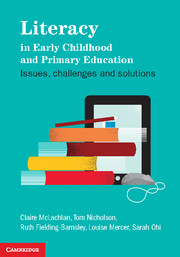Book contents
- Frontmatter
- Contents
- List of figures
- List of tables
- About the authors
- Acknowledgements
- Chapter 1 Introduction
- Part 1 Literacy acquisition: the child, the family and diversity in the modern world
- Part 2 Learning about literacy in early childhood settings
- Chapter 7 Effective practice and the role of teachers in supporting literacy
- Chapter 8 ‘Sound’ foundations for learning literacy
- Chapter 9 Uses of assessment before, during and after transition to school
- Part 3 Literacy learning in the primary school
- Part 4 Literacy learning in the senior primary school
- References
- Index
- References
Chapter 7 - Effective practice and the role of teachers in supporting literacy
from Part 2 - Learning about literacy in early childhood settings
- Frontmatter
- Contents
- List of figures
- List of tables
- About the authors
- Acknowledgements
- Chapter 1 Introduction
- Part 1 Literacy acquisition: the child, the family and diversity in the modern world
- Part 2 Learning about literacy in early childhood settings
- Chapter 7 Effective practice and the role of teachers in supporting literacy
- Chapter 8 ‘Sound’ foundations for learning literacy
- Chapter 9 Uses of assessment before, during and after transition to school
- Part 3 Literacy learning in the primary school
- Part 4 Literacy learning in the senior primary school
- References
- Index
- References
Summary
Chapter objectives
To critically examine the notion of a high-quality literacy environment for early childhood.
To identify the features of an enriched literacy environment that supports literacy acquisition.
To critique the role of teachers in promoting young children’s literacy.
This chapter explores the growing body of research on how to provide both access to high-quality literacy environments and the effective mediation of literacy in early childhood settings. Drawing on a range of research on the features of effective literacy environments, this chapter discusses principles for curriculum and centre design. In addition it examines the role of teachers in supporting literacy acquisition and, in particular, recent research which has explored the range, type and amount of teacher involvement in children’s literacy acquisition. This chapter critiques what Cunningham et al. (2004) call ‘knowledge calibration’ in effective early childhood teachers.
High-quality literacy environments: what are they and how can you create one?
A quality literacy environment is one that is well resourced with literacy materials and in which children experience effective teaching and learning practices that make a difference to their literacy learning outcomes. This section explores what ‘quality’ means and how dei nitions have changed over time.
- Type
- Chapter
- Information
- Literacy in Early Childhood and Primary EducationIssues, Challenges, Solutions, pp. 101 - 120Publisher: Cambridge University PressPrint publication year: 2012



